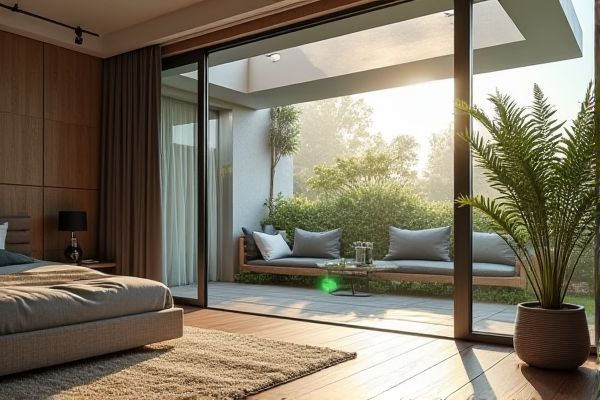
Windbreakers provide effective protection against strong winds while maintaining an open terrace view, making your outdoor space comfortable without sacrificing aesthetics. Privacy screens, on the other hand, prioritize shielding your terrace from onlookers, creating a secluded atmosphere ideal for relaxation; explore the article to discover which option suits your needs best.
Table of Comparison
| Feature | Windbreakers | Privacy Screens (Terrace) |
|---|---|---|
| Primary Purpose | Block wind and reduce airflow | Provide visual privacy and block views |
| Material | Mesh, fabric, or solid panels designed to resist wind | Wood, metal, fabric, bamboo, or synthetic panels |
| Transparency | Partially transparent to manage airflow | Usually opaque or semi-opaque for privacy |
| Installation | Mounted on poles, frames, or railings | Fixed panels, screens, or fences attached to terrace edges |
| Wind Protection | High - designed specifically to reduce wind impact | Low to moderate - depends on material and design |
| Privacy Level | Low to moderate | High |
| Durability | Weather-resistant fabrics and frames | Often more durable using wood, metal, or treated materials |
| Aesthetic Options | Functional, often minimalist | Varied designs for style and decoration |
| Cost | Generally affordable | Varies widely based on material and design |
Introduction to Terrace Windbreakers and Privacy Screens
Terrace windbreakers and privacy screens serve distinct purposes for outdoor spaces, with windbreakers designed primarily to reduce wind exposure and privacy screens aimed at creating secluded areas. Windbreakers typically use materials like tempered glass or sturdy mesh that allow airflow while blocking strong gusts, enhancing comfort on terraces. Privacy screens often feature opaque panels or dense foliage that obstruct sightlines, providing discretion and an intimate atmosphere.
Key Differences Between Windbreakers and Privacy Screens
Windbreakers primarily serve to reduce wind speed and create a sheltered outdoor space, typically constructed from durable, weather-resistant materials like mesh or fabric designed to block airflow. Privacy screens emphasize visual blockage using opaque or semi-opaque panels made of wood, metal, or fabric, providing seclusion rather than protection from the elements. Windbreakers often feature adjustable or removable panels for versatility against changing wind conditions, while privacy screens are more static structures focused on maintaining privacy on terraces or patios.
Material Options for Terrace Windbreakers
Terrace windbreakers are available in a variety of materials, including tempered glass, polycarbonate panels, acrylic, and mesh fabric, each offering different levels of durability, transparency, and wind resistance. Tempered glass provides a stylish, clear barrier that withstands strong winds and weather conditions, making it ideal for modern terrace designs. Mesh fabric and polycarbonate panels offer lightweight, flexible options with excellent airflow and privacy control, suitable for varying terrace environments.
Material Choices for Privacy Screens
Privacy screens for terraces often feature materials such as bamboo, mesh fabric, wood, and metal, each providing varying levels of durability, weather resistance, and visual obstruction. Windbreakers, typically made from polyester or nylon, prioritize wind reduction but may lack the opacity and privacy levels of dedicated privacy screens. Your choice should balance the desired privacy, aesthetic preferences, and maintenance requirements associated with these material options.
Installation Process: Windbreakers vs Privacy Screens
Windbreakers typically feature a straightforward installation process involving mounting on existing terrace railings or posts using brackets or clamps, requiring minimal tools and time. Privacy screens often require more customization, such as securing panels to posts with screws or anchors, and may necessitate a more precise alignment to ensure privacy and stability. Both options can be DIY-friendly, but privacy screens might demand additional preparation depending on terrace structure and materials used.
Weather Protection: Which Offers Better Shelter?
Windbreakers provide superior shelter against strong winds and rain due to their durable, water-resistant materials specifically designed to block gusts and moisture. Privacy screens offer moderate weather protection but are primarily intended for visual shielding, often made from mesh or fabric that allows airflow and limited resistance to elements. Choosing windbreakers ensures enhanced coverage in adverse weather conditions on terraces, whereas privacy screens excel in creating secluded spaces with some shelter.
Privacy Enhancement: Windbreakers or Screens?
Windbreakers and privacy screens both enhance terrace privacy, but privacy screens offer superior visual blockage due to their solid or dense materials designed specifically for shielding views. Windbreakers mainly act as barriers against wind while providing some level of privacy with mesh or fabric construction. Choosing privacy screens ensures maximum seclusion on terraces by effectively obstructing sightlines from neighbors and passersby.
Design and Aesthetic Considerations
Windbreakers on terraces often feature sleek, modern designs with transparent or semi-transparent materials like glass or acrylic, offering unobstructed views while enhancing outdoor aesthetics. Privacy screens typically incorporate decorative elements such as wood slats, lattice patterns, or fabric panels, blending functionality with style to create intimate and visually appealing spaces. Selecting between windbreakers and privacy screens depends on desired visual openness, design harmony with the terrace, and the level of privacy needed.
Maintenance Requirements and Durability
Windbreakers, often made from durable, weather-resistant fabrics like polyester or acrylic, require regular cleaning and occasional waterproofing treatments to maintain their effectiveness, especially after exposure to harsh weather. Privacy screens, typically constructed from materials such as bamboo, wood, or metal, demand varying maintenance levels; wood screens need sealing or staining to prevent rot and insect damage, while metal screens require rust prevention measures. Durability for windbreakers depends on fabric quality and UV resistance, while privacy screens offer longer-lasting structural stability but may need more intensive upkeep based on material type.
Cost Comparison and Value for Terrace Owners
Windbreakers generally cost less upfront than privacy screens but may offer less durable protection against wind and visibility on your terrace. Privacy screens often represent a higher initial investment but provide enhanced privacy, durability, and aesthetic appeal that increase the overall value of your outdoor space. Considering long-term benefits and maintenance, privacy screens deliver greater value for terrace owners seeking a combination of function and style.
 homyna.com
homyna.com